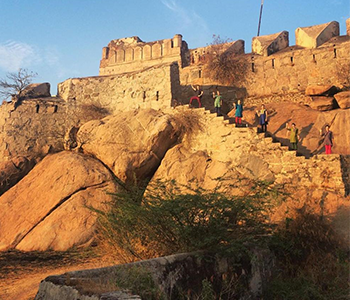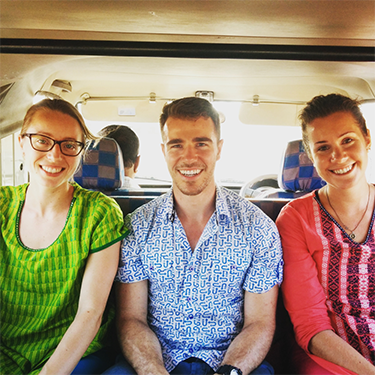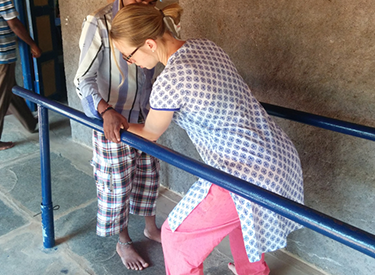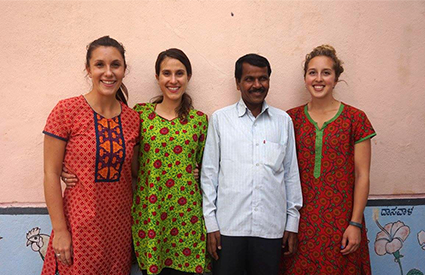
After a 31-hour flight, it would take numerous taxi rides, an overnight train, followed by several auto rickshaw and motorbike trips — all in forty-degree heat — to reach their destination: Koppal, a rural district in the southern state of Karnataka, India.
Over the next five weeks, as part of an international clinical placement opportunity through UBC’s Master of Physical Therapy program, UBC students Mary-Anne Levson, Matt Redekopp, Rachelle MacDonald and Kate Shaw would come to know the surrounding region — and some of its most vulnerable populations — more intimately.
Under the supervision and guidance of physical therapists Juliet Grundmanis and Brooke Hannela, the students teamed up with NGO Samuha Samarthya to offer education and support to local rehabilitation therapists working with adults with spinal cord injuries and children with a variety of conditions, ranging from cerebral palsy to club foot.
Now back in Canada, they reveal what their experience in India was like, and what they’ve taken away from their time abroad.
Mary-Anne Levson + Matt Redekopp

UBC physical therapy students Mary-Anne Levson (left) and Matt Redekopp with their preceptor Juliet Grundmanis in India.
Describe where you were based.
We were based at the Spinal-cord Rehabilitation Centre (SRC), a 30-minute drive off the beaten path east of Koppal. The facility is one of only two in the state that caters to clients with spinal cord injuries.
What services are offered at the centre?
Prior to coming to the centre, many patients remain isolated in their homes without a treatment plan, home exercises, the knowledge of how to transfer or perform everyday activities, and often without a wheelchair or bed. The centre provides them with a location to stay for up to three months, where they receive full-time rehabilitation and education, accommodation, meals, a new wheelchair, and the support from staff and their peers. Ultimately, the goal is to see these individuals become more independent over time.
In addition to the three-month camps, the facility follows up with past clients and offers a 10-day camp, where patients come to receive progressions to treatment, continuing education, social support, and medical checkups.
As students, what was your goal over the course of your time at the centre?
Our main goal was to help train the local therapists on some of the major concepts related to spinal cord injury rehabilitation, such as exercise therapy, physiotherapy assessments, discharge planning, anatomy of the body, and programs to promote independence for life. For the majority of our five weeks, we focused on physiotherapy teaching topics related to spinal cord injury patients. As is customary in India, we worked six days a week, which allowed us to teach as many topics to the therapists as possible, with Sunday being our rest/relax/exploration day.

Mary-Anne Levson seen working at the Spinal-cord Rehabilitation Centre in Koppal, India.
What was the highlight of your time in India?
The loving, friendly people that we met in India, along with the amazing team of volunteers who came with us have definitely been the highlight of the trip! In addition to working hard, we thoroughly enjoyed our time with the community of the SRC. Days were filled with smiles, frequent chai tea breaks, fresh coconuts delivered by bike, incredible home-made meals, and games with families and children.
Before coming to India, we also did a lot of fundraising so that the centre could purchase more wheelchairs and additional training equipment specifically tailored for spinal cord injury patients. Many clients who came to camp without a wheelchair, have now received a wheelchair with off-road capabilities, allowing them to return home with mobility and independence. It was great to see the life-changing impact that these new resources have made to the community.
What lesson did you take away from your time abroad?
It is important to remember that volunteering overseas can be detrimental if we try to impose our methods on the local workers rather than promoting sustainability of the organization by facilitating culturally appropriate changes that are driven by the local workers goals. It would have been easy for us to arrive in India, work really hard on our clinical skills for 5 weeks and then leave, but that wouldn’t be helpful for the local workers because they wouldn’t be able to continue our Canadian methods after our departure. Instead, our focus was on teaching them skills, answering questions and improving their practice within the boundaries of cultural norms and community beliefs.
We truly believe that seizing opportunities as they arise, such as this international placement, is so important as it has changed our lives for the better and not only strengthened our professional development but has also given us new perspective as individuals!
Rachelle MacDonald and Kate Shaw

Preceptor Brooke Hannela (left) stands alongside and physical therapy students Kate Shaw and Rachelle MacDonald (far right), as well as the clinic supervisor in Deodurg, India.
Describe where you were based.
Over the course of our five-week placement, we split our time between two early intervention centres in Koppal and Deodurg, both in the state of Karnataka, but about a 6-hour drive apart. Even as smaller towns, both Koppal and Deodurg are bustling with people and traffic and a lot of members of the bovine family roaming around the streets!
What did a typical day look like for you?
There wasn’t really a typical day! Every day was different, and each child and family was different. Over the course of our time, we saw children with a variety of conditions, including cerebral palsy, developmental delay, spina bifida, scoliosis, and club foot. Often we would spend mornings researching and learning about new conditions since things don’t get started in India until after 10am, and then we’d have set tea time at 11am. We’d see a child for their therapy session and many family members would sit in, which made it very crowded and sometimes hard to communicate. Sometimes we would have surprise visits from adult patients. We learned to expect the unexpected and to go with the flow!
While we were there to learn clinically, the focus of our time was sustainable healthcare through education so that the local clinic can provide the best care while being self-sufficient, rather than being dependent on helicopter volunteering.
What were some of the biggest challenges you faced?
The language barrier in a clinical setting was one of the biggest challenges we faced – but with a lot of patience, body language, small chunks of Kanenglish (a smattering of Kannada, the local language, and English), and the use of translators wherever possible, we managed to get by.
What was the highlight of your time in India?
It was wonderful to spend time in an area of practice that we’re very interested in (pediatrics) but in a cultural and clinical setting that’s so different from home. It was amazing to connect with the kids and their families, and was very rewarding to see the parents become more comfortable with their child’s exercises or more knowledgeable about their child’s condition. We hope that we’ve impacted these families in a positive way.
What was the highlight of your time in India?
Travel as much as possible, and seize every opportunity to better yourself as a clinician in different settings (don’t just settle into your comfort zone). Global health is important, and education is key.
To read more about their time in India, visit www.ubcsamuha.wordpress.com